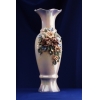|
 The year 1709
was the time which marked the birth of Meissen China as one of the very
important commercial and scientific aims of the past 300 years. These ambitions
lead Johann Friedrich Böttger to discover hard-paste white European porcelain. The year 1709
was the time which marked the birth of Meissen China as one of the very
important commercial and scientific aims of the past 300 years. These ambitions
lead Johann Friedrich Böttger to discover hard-paste white European porcelain.
Meissen
porcelain with its logo of crossed swords was set out to conquer the whole of
Europe and the world. All Meissen china is painted by hand as it was all the
time. The paint is mixed by the ancient formula and by Meissen there are over 10
000 tints available. Currently all works of art seem to be replica of tableware
and figures of old times and Meissen manufacture approximately 175 000 types of
china items. Let's go back to the some piece of history.
In 1707 in
the city of Meissen the pharmacist and the alchemist Böttger managed to discover
the secret of hard porcelain, as well as the process of ceramics and glaze firing.
Primarily, Johann Friedrich Böttger, under the patronage of King Augustus the
Strong, was to get gold from cheaper materials. When he failed to do that, Augustus
allowed Böttger conduct his own investigations to get china of high quality
under supervision of the scientist Ehrenfried Walther von Tschirnhaus. Augustus
the Strong immediately recognized that the "white gold" was of almost
the same value as genuine gold.
In 1708 Böttger
reported the discovery of good white porcelain and in 1710 the Meissen Royal
Manufactory was based in Meissen, where the best porcelain in Europe was made
within 300 years. When the porcelain disseminated in Europe, it attracted
attention of the most legendary and richest people of the world. The nobles had
their tables served with German china that resembled Chinese porcelain that
time.
Meissen Royal
Manufactory activity has undergone three significant stages. First stage refers
to the time of foundation when porcelain was predominantly examined, new paints
created, thus came the time by the alchemist Böttger up to 1722. The second stage,
«pictorial», refers to manufacture of painted tableware and decorative vases, thus
the time by the painter Johan Gregorius Höroldt from 1722 to 1733. A specialist in the
chemistry of color, he developed approximately ten thousand brilliant,
verifiable pigments. These pigments are still in use today for decorating
Meissen porcelain. The third stage, «sculptural» within 1735 to 1760 when big
sculptures were manufactured followed by the time of small figures, the time by
the sculptor Johann Joachim Kaendler, a particularly skilled sculptor, who developed
the many sculptures, figures and tableware sets that have endure in charm for
nearly 300 years. «Pictorial» and «sculptural» stages of porcelain manufacture
are commonly seen in replica works and are highly valued in ancient works of
art. They were followed by many personalities who either copied their own works
either replicated the works by other porcelain manufactures (during the crisis
period).
«Pictorial»
period is distinguished with vivid paints and plenty of Chinese motifs.
Porcelain was primarily considered as the Oriental beauty. «Golden Chinese
people», «Red-and-golden Dragons» and exotic flora and fauna things and scenes
from Chinese life.
During the time
of Johann Joachim Kaendler the porcelain was not considered the exotic material
any longer, therefore during late 1720 and early 1730 Kirhner and Kaendler created
the whole line of big size sculpture of saint people and animals. The project, however,
failed since during the process of abundant porcelain firing, the material would
sink, deformed and cracked, that was the end of this project and the
manufacture was aimed at production of smaller figures. The most reputed designed
figures of those times were later replicated by famous porcelain factories,
like the series of «Italian comedians», «Monkey Capella», the court, artisans,
merchants, peasants, soldiers, mythological characters, birds and animals, very
complicated allegoric compositions and pastorals. In the late XVIII century the
figures of healthy German kids won the popularity that were presented as
Ancient Greek Gods, allegoric seasons, gardeners and wine-growers.
Currently
wherever you go to buy Meissen porcelain, you get its replica. The difference in
price is conditioned by the fact whenever the replica was made, in XIX or XX century.
Yet, you may be confident that the porcelain you acquired dates some period back
providing there is the analog in the museum that is dated referring to sources
in writing.
Even if you
fail to be a big china-hunter who will do a lot to acquire rarities by Meissen
Manufacture, then anyway you will be satisfied to have modern porcelain items
manufactured by old formula and design.
|